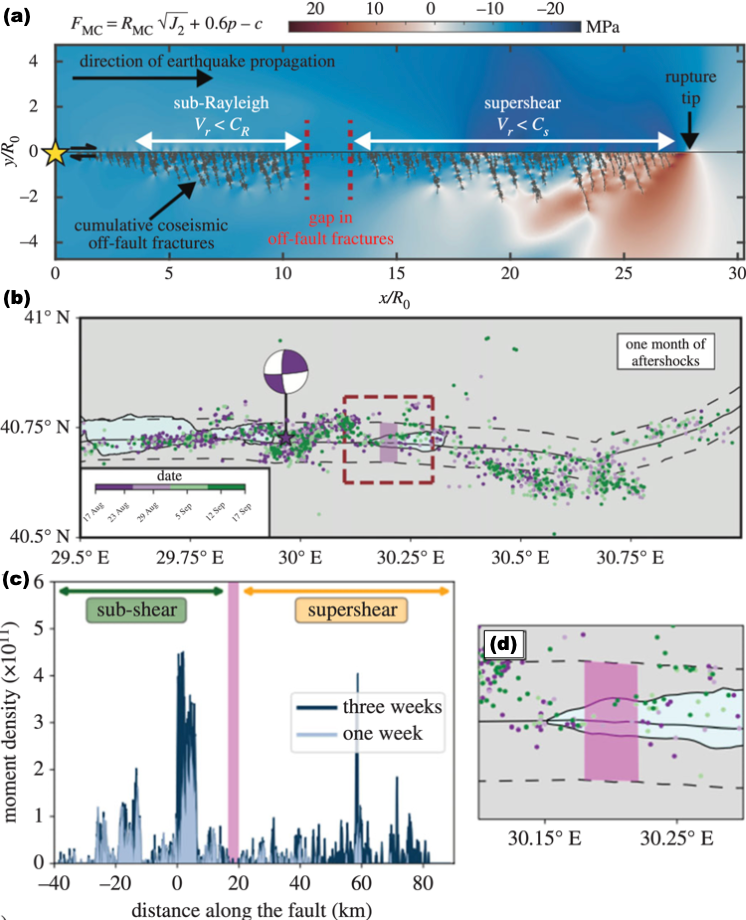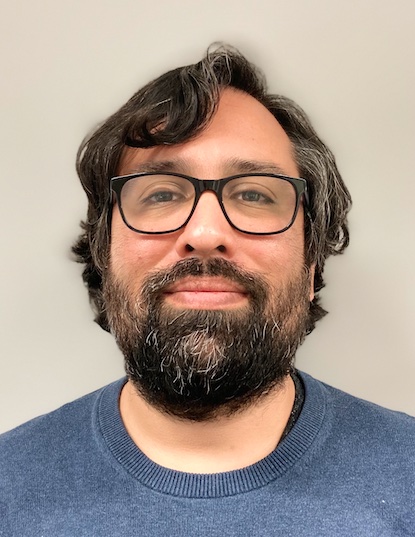Supershear Transition
Supershear Transition
While Rayleigh and shear wave speeds typically limit the rupture velocity of most EQs, some events can transition to higher, so-called "supershear" speeds. The location of the transition from subshear to supershear speeds is inferred through seismological and geodetic inversions and is presumed to occur between the subshear and supershear segments. Our theoretical arguments and numerical models, which account for coseismic off-fault damage, demonstrate that the supershear transition is characterized by a significant reduction in the width of the off-fault damage zone. We have further validated this phenomenon by analyzing natural observations of coseismic off-fault damage zone width using image correlation and aftershock catalog analysis\citep{Jara21}. This collaborative effort, which brings together expertise in seismogeodesy, fracture mechanics, tectonics, and numerical modeling, opens new avenues of exploration into how fast rupture speeds relate to aftershock productivity, high-frequency radiation, local tectonic settings, and fault geometrical complexities such as fault zone extensions, damage zones, and branching. Despite these efforts, however, this topic remains poorly understood.
High-frequency radiation and its link with rupture speed
During my current postdoc as a Marie-Curie fellow at GFZ in Potsdam, I am investigating the spatio-temporal distribution of high-frequency radiation produced by EQs. To achieve this, I am implementing a Bayesian kinematic source inversion model in the frequency domain to explore the relationship between the EQ rupture speed and high-frequency radiation. Firstly, I aim to determine whether the deeper part of the seismogenic zone produces higher frequency content, by studying the $M_w$ 7.7 Tocopilla EQ in northern Chile. Secondly, I will examine whether regions where EQs transition to supershear speed are natural sources of high-frequency radiation, as abrupt changes in rupture speed can generate such radiation. Both results will be combined with as much geophysical information as possible to discuss the link between high-frequency radiation and tectonic features. Therefore, the project will provide insights into how to track these high-frequency sources and understand their distribution over time and space.

(a) Changes in closeness to failure associated with Drucker-Prager failure criterion, computed by dynamic simulations, including coseismic off-fault damage generated by the rupture propagation. (b) 1-month aftershock distribution for Izmit EQ, color-coded by time. The continuous black line denotes the EQ surface rupture. (c) Cumulative seismic moment density at different temporal scales (one to three weeks) for Izmit EQ. Aftershocks within a distance of 5 km from the fault are considered (area denoted by the discontinuous black lines in b). Color-coded arrows indicate the different speed regimes reported for this event (green for sub-Rayleigh and orange for supershear), while the pink box denotes the work’s proposed Transition Zone. (d) Map view zoom on the transition region proposed in this study.
Relevant publications
Signature of transition to supershear rupture speed in the coseismic off-fault damage zone
Jara, J., Bruhat, L., Thomas, M. Y., Antoine, S. L., Okubo, K., Rougier, E., Rosakis, A. J., Sammis, C. G., Klinger, Y., Jolivet, R., & Bhat, H. S. PRSA, 2021, 477(2255). doi:10.1098/rspa.2021.0364
Jara, J., Delgado, F., Raimbault, B., Jolivet, R. \& Vigny, C. The 2007 Aysén earthquakes in southern Chile, a seismogeodetic approach. To be submitted to GRL
Jara, J. & Cotton, F. To be submitted to GJI. A Bayesian Kinematic Source Model in the Frequency Domain: towards under- standing sources of high-frequency radiation.
